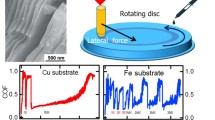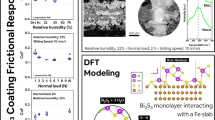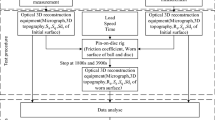Abstract
The tribological behavior of self-mated Ti3SiC2 in bath of alcohols are investigated at sliding velocity ranging from 0.005 to 0.3 m/s. The results show that the friction coefficient and wear rates of self-mated Ti3SiC2 are reduced greatly under lubrication of alcohols compared to that under dry condition. In alcohols, smooth worn surfaces of Ti3SiC2 can be obtained. The mechanical wear is inhibited and the oxidized Ti and Si species on the worn surface are TiO2 and silica gel. The friction coefficients decrease with carbon numbers and sliding velocity in the n-alcohols. The friction coefficient decrease with sliding velocity in glycol and glycerol as well. The decrease is determined by the increase of the viscosity of alcohols. In glycerol, at 0.1 m/s and 5 N, the friction coefficient of self-mated Ti3SiC2 is 0.08 which is the lowest in this paper. The lubrication regimes are calculated according to classical lubrication theory. At velocity from 0.005 to 0.3 m/s, in all of the alcohols except glycerol, the λ are below 1 which indicates that the lubrication regime is BL. While in glycerol, the lubrication regimes vary from BL to BL and EHL, then to EHL as the velocity increases.








Similar content being viewed by others
References
Barsoum, M.W.: The Mn+1AXn phases: a new class of solids; thermodynamically stable nanolaminates. Prog. Solid State Chem. 28, 201–281 (2000)
Barsoum, M.W., El-Raghy, T.: Synthesis and characterization of a remarkable ceramic: Ti3SiC2. J. Am. Ceram. Soc. 79, 1953–1956 (1996)
Hibi, Y., Miyake, K., Murakami, T., Sasaki, S.: Tribological behavior of SiC-reinforced Ti3SiC2-based composites under dry condition and under lubricated condition with water and ethanol. J. Am. Ceram. Soc. 89, 2983–2985 (2006)
Du, Z., Ren, S., Wang, J., Meng, J., Lu, J.: Tribological properties of Ti3SiC2-Al2O3 composites in different liquid. Tribology (in Chinese) 30, 223–228 (2010)
Hai, W., Zeng, J., Ren, S., Meng, J., Lu, J.: The tribological behavior and tribochemistry of self-mated Ti3SiC2 in ethanol. Tribol. Lett. 50, 449–455 (2013)
Tomizawa, H., Fischer, T.E.: Friction and wear of silicon nitride and silicon carbide in water hydrodynamic lubrication at low sliding speed obtained by tribochemical wear. ASLE Trans. 30, 41–46 (1987)
Hibi, Y., Enomoto, Y.: Tribochemical wear of silicon nitride in water, alcohols and their mixture. Wear 133(1989), 133–145 (1989)
Gates, R.S., Hsu, S.M.: Silicon nitride boundary lubrication: Lubrication mechanism of alcohols. Tribol. Trans. 38(3), 645–653 (1995)
Zhang, W., Liu, W., Yu, L.: Friction and wear behaviors of a (Ca, Mg)-sialon/SAE 52100 steel pair under the lubrication of various polyols as water-based lubricating additives. Tribol. Int. 33, 769–775 (2000)
Hibi, Y., Enomoto, Y., Tanaka, A.: Lubricity of metal ethoxide formed on sliding surfaces of Si3N4–TiN–Ti composites in ethanol. J. Mater. Sci. Lett. 19, 1809–1812 (2000)
Dante, R.C., Kajdas, C.K.: A review and a fundamental theory of silicon nitride tribochemistry. Wear 288, 27–38 (2012)
Ren, S., Meng, J., Lu, J., Yang, S.: Tribological behavior of Ti3SiC2 sliding against Ni-based alloys. Tribol. Lett. 31, 129–137 (2008)
Peterson, M.B.: Design considerations for effective wear control wear control handbook. American Society of Mechanical Engineers, New York (1980)
Hai, W., Ren, S., Meng, J., Lu, J.: Tribo-oxidation of self-mated Ti3SiC2 at elevated temperatures and low speed. Tribol. Lett. 48, 425–432 (2012)
Matta, C., Joly-Pottuz, L., Bouchet, M., Martin, J.M.: Superlubricity and tribochemistry of polyhydric alcohols. Phys. Rev. B 78, 085436 (2008)
Chen, M., Kato, K., Adachi, K.: The comparisons of sliding speed and normal load effect on friction coefficients of self-mated Si3N4 and SiC under water lubrication. Tribol. Int. 35, 129–135 (2002)
Wen, S., Huang, P.: Principles of tribology. Tsinghua University Press, Beijing (2008)
Dowson, D., Ehret, P.: Past, present and future studies in elastohydrodynamics. J. Eng. Trib. 213, 317–333 (1999)
Acknowledgments
The author acknowledges the financial support from the National Natural Science Foundation of China (51075382 and 51375473) and the “Hundred Talents Program” (Junhu Meng) of Chinese Academy of Sciences.
Author information
Authors and Affiliations
Corresponding author
Rights and permissions
About this article
Cite this article
Hai, W., Zeng, J., Ren, S. et al. Tribological Behavior of Self-mated Ti3SiC2 in Short-Chain n-Alcohols, Glycol and Glycerol under Boundary Lubrication. Tribol Lett 55, 421–428 (2014). https://doi.org/10.1007/s11249-014-0374-4
Received:
Accepted:
Published:
Issue Date:
DOI: https://doi.org/10.1007/s11249-014-0374-4




